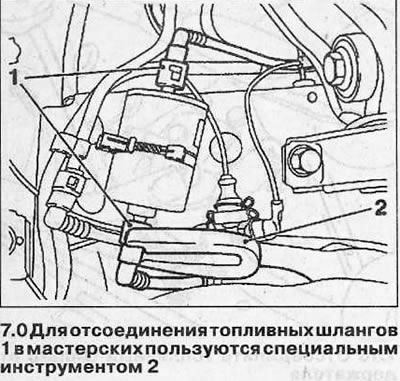Condensate removal
Special tools and fixtures are not required.
Necessary parts to replace worn ones:
- fuel filter corresponding to the type of engine,
- filter seals (vehicles with X25DT engine) or filter cover (vehicles with 2.0/2.2 l engine).
A special container is required to collect condensate.
Attention! Do not allow diesel fuel to come into contact with rubber parts, especially cooling system hoses. If fuel comes into contact with these parts, remove the fuel immediately, because the remaining fuel on them will destroy them over time.
Vehicles with a 2.5L diesel engine (X25DT)
1. Release the drain hose 1 from the holder and lower it down (see illustration).

2. Place a container under the hose to collect condensate.
3. Loosen the bolt 2 of the ventilation hole on the filter cover (see illustration 7.1).
4. Unscrew the condensate drain plug at the bottom of the filter housing and drain approximately 100 cmZ condensate (see illustration 7.1). As soon as fuel starts to flow out of the filter, tighten the drain plug.
5. Tighten the drain plug and vent screw.
6. Fix hose 1 in the holder (see illustration 7.1).
Attention! After draining the condensate, bleeding the fuel system is not required.
Fuel filter replacement
7. Completely drain the condensate from the fuel filter.
8. Disconnect the drain hose from the filter.
9. Disconnect the fuel line 1 from the filter cover (see illustration).

10. Disconnect the fuel filter from the holder and remove it (see illustration).

11. Install and screw on a new filter by hand, after wetting the gasket with diesel fuel.
12. Connect the fuel line to the filter, tightening it with a torque of 15 Nm, installing new seals.
13. Connect a condensate drain hose to the fuel filter.
Vehicles with a 2.5L diesel engine (Y25DT)
Attention! In accordance with the maintenance plan for vehicles with a 150 hp engine. draining the condensate from the fuel filter is not required.
14. Disconnect the plug from the fuel pressure sensor on the fuel filter housing.
15. Disconnect the fuel lines from the filter, marking their mounting position.
16. Unscrew a bolt and remove the fuel filter from an arm.
17. Install a new fuel filter and connect the fuel lines and fuel pressure sensor plug. If necessary, bleed the fuel system by turning on the ignition for about one minute.
Condensate removal
Vehicles with 2.0/2.2 L diesel engine
18. Place a container under the fuel filter to collect condensate.
19. Unscrew the condensate drain plug at the bottom of the filter housing by about one turn (see arrow in illustration).

20. Loosen the central bolt on the fuel filter cap and drain about 100 cm3 condensate. As soon as fuel starts to flow out of the filter, tighten the drain plug.
Attention! Never empty the fuel filter, otherwise you will have to remove air from the fuel system in the workshop.
21. Tighten the center bolt and drain plug to the specified torque.
Fuel filter replacement
22. Loosen the center bolt on top of the filter housing.
23. Release the fuel filter from the holder by pushing it up.
24. Disconnect the fuel filter heater plug.
25. Disconnect both fuel hoses from the filter cover using the HAZET 4501-1 special tool.
26. Completely unscrew the central bolt, remove the cover and remove the replacement filter element.
Attention! The filter is filled to the brim with diesel fuel.
27. Drain the fuel from the filter and wipe it.
28. Install a new filter element and replace with new gaskets for the center bolt and filter housing.
29. Fill the filter to the brim with clean diesel fuel and reinstall in the reverse order of removal. Check that the quick-release fasteners on the fuel hoses click into place, which is accompanied by a clearly audible click.
Attention! If the engine does not start, it is necessary to remove air from the fuel system by contacting a workshop.
Fuel filter replacement
Cars with a gasoline engine
The fuel filter is located on the bottom of the car on the right near the fuel tank. A jack and jack stands are required for replacement.
To disconnect fuel hoses 1 in workshops, use a special tool 2, for example, Opel KM-796 or HAZET 4501-1 (see illustration 7.0).

Withdrawal
30. Relieve the pressure in the fuel system,
31. Jack up the car and place it on jack stands.
32. Install a container under the fuel filter to collect fuel.
33. Mark the supply and return hoses with tape so as not to confuse them when connecting to a new filter.
34. Disconnect the fuel hose clamps with the HAZET 4501-1 special tool and disconnect the supply and return hoses.
35. Remove the fuel filter and drain the fuel from it.
Installation
36. Move clamps 1 from the old filter to the new one (see illustration).

Attention! When installing the filter, follow the arrow on its body, which indicates the direction of fuel movement from the tank to the engine.
37. Install the fuel filter in the holder and secure.
38. Connect fuel hoses to the filter.
39. Lower the car on wheels.
40. Carry out a test drive, and then check the tightness of the connection of the fuel hoses.

Visitor comments